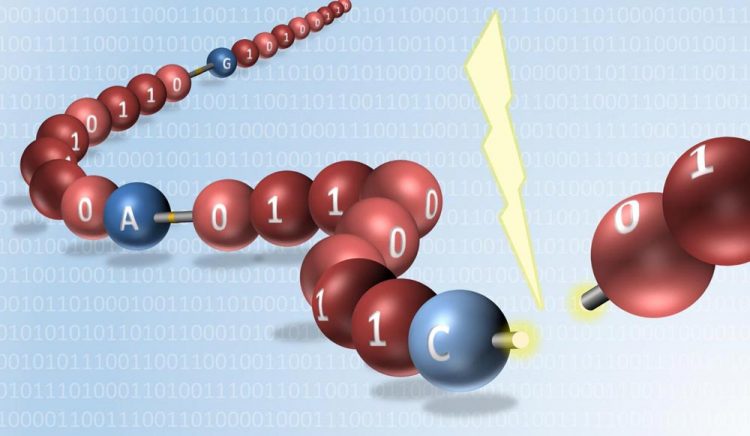World first for reading digitally encoded synthetic molecules

By inserting fragile bonds between each molecular 'byte,' digital polymers may be easily read through mass spectrometry. Credit: Jean-François Lutz, Institut Charles Sadron (CNRS)
Will hard drives one day use polymers for data storage? For several years now, researchers have faced the challenge of trying to record information with these long molecules. Polymers have great potential since, to record a bit,1 their component monomers require 100 times less space than current hard drives.
Their use could therefore dramatically reduce the size of computer storage media. Yet researchers have been thwarted in their efforts to effectively read polymer data. Now a team of CNRS and Aix-Marseille University scientists has demonstrated that a mass spectrometer may be used to read long sequences of data recorded on a molecular scale. This is a breakthrough because mass spectrometers, popular among chemists, are fast and easy to use.
To pull it off, the team used synthetic molecules, simpler to work with than natural molecules like DNA. Their structure was optimized for sequencing by mass spectrometry. The polymers are made up of two kinds of monomers (with phosphate groups)–corresponding to 0 and 1 respectively. After every eight of these monomer “bits,” a molecular separator was added.
The number of bytes represented by the complete polymer equals the number of eight-bit groups. The first step in reading the encoded information is to divide the polymer into molecular bytes by snapping it apart at the separator sites; the next is to break the phosphate bonds, for sequencing of each byte.
The team of chemists managed to synthesize polymers that can store up to eight bytes. Thus, they were able to record the word “Sequence” in ASCII code, which assigns a unique byte to each letter and punctuation mark. By successfully decoding this word using mass spectrometry, they set a new record for the length of a molecule that may be read using this technique.
Although manual analysis of the digital data does take a few hours, it should be possible to reduce the time needed to a few milliseconds by developing software to perform this task. By associating short read times with current automated methods for writing data, this work paves the way for synthetic polymer storage of several kilobytes of data, roughly equivalent to a page of text — just like the very first floppy disks.
###
[1] A byte is a segment of information consisting of eight subunits called bits. Bits, which represent the lowest level of data, can each have only one of two possible values: 0 or 1.
Media Contact
All latest news from the category: Life Sciences and Chemistry
Articles and reports from the Life Sciences and chemistry area deal with applied and basic research into modern biology, chemistry and human medicine.
Valuable information can be found on a range of life sciences fields including bacteriology, biochemistry, bionics, bioinformatics, biophysics, biotechnology, genetics, geobotany, human biology, marine biology, microbiology, molecular biology, cellular biology, zoology, bioinorganic chemistry, microchemistry and environmental chemistry.
Newest articles

Innovative vortex beam technology
…unleashes ultra-secure, high-capacity data transmission. Scientists have developed a breakthrough optical technology that could dramatically enhance the capacity and security of data transmission (Fig. 1). By utilizing a new type…

Tiny dancers: Scientists synchronise bacterial motion
Researchers at TU Delft have discovered that E. coli bacteria can synchronise their movements, creating order in seemingly random biological systems. By trapping individual bacteria in micro-engineered circular cavities and…

Primary investigation on ram-rotor detonation engine
Detonation is a supersonic combustion wave, characterized by a shock wave driven by the energy release from closely coupled chemical reactions. It is a typical form of pressure gain combustion,…



